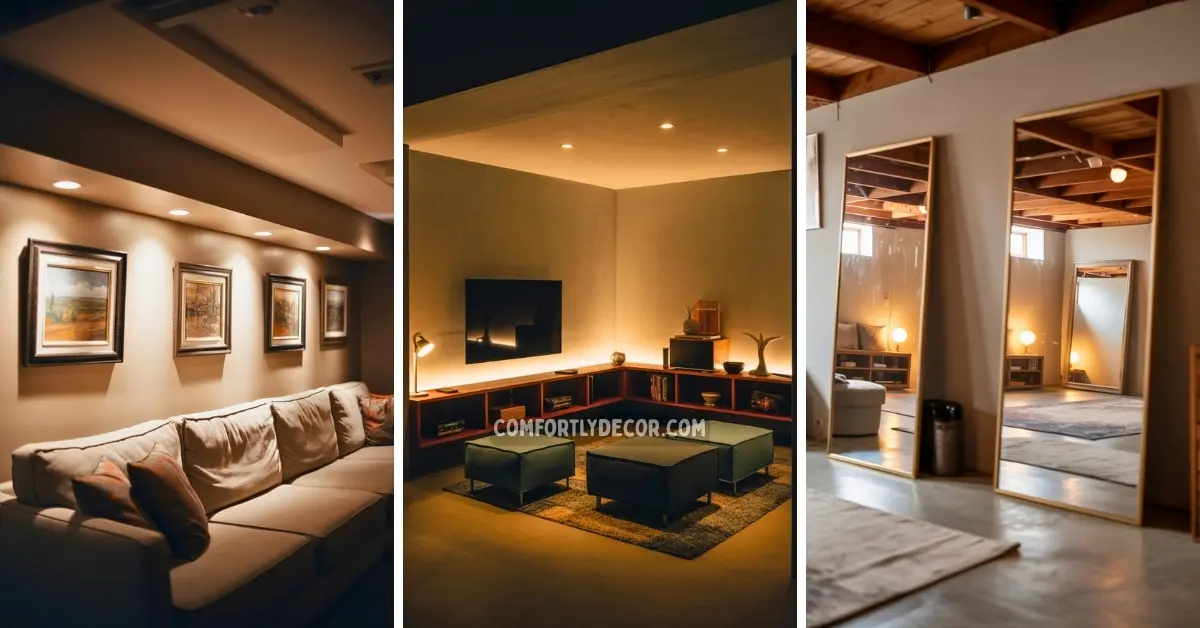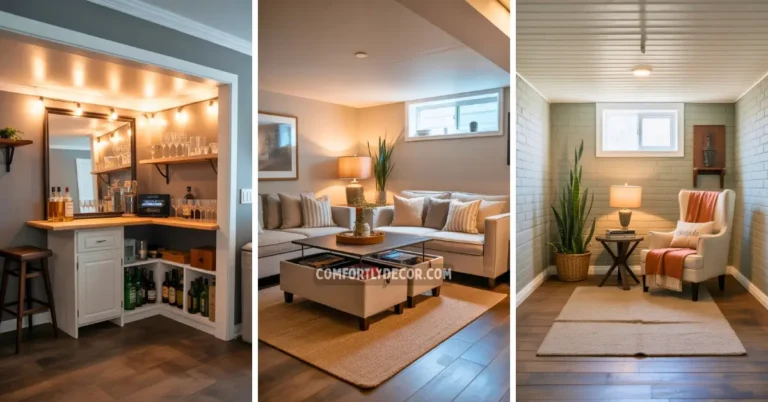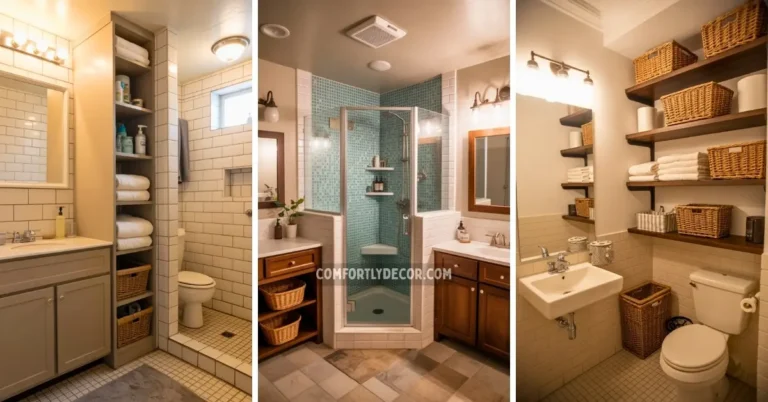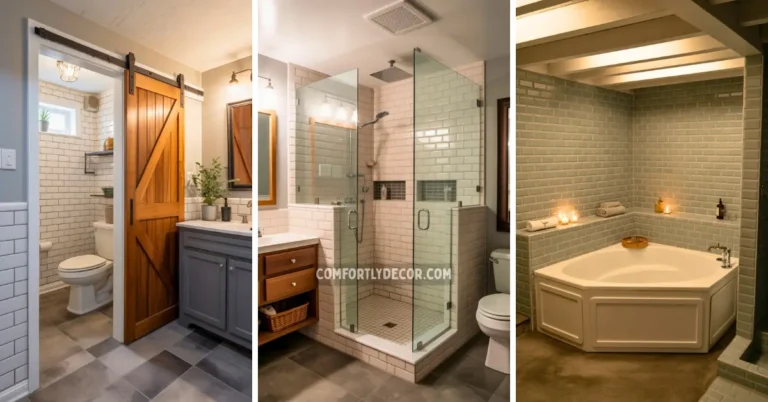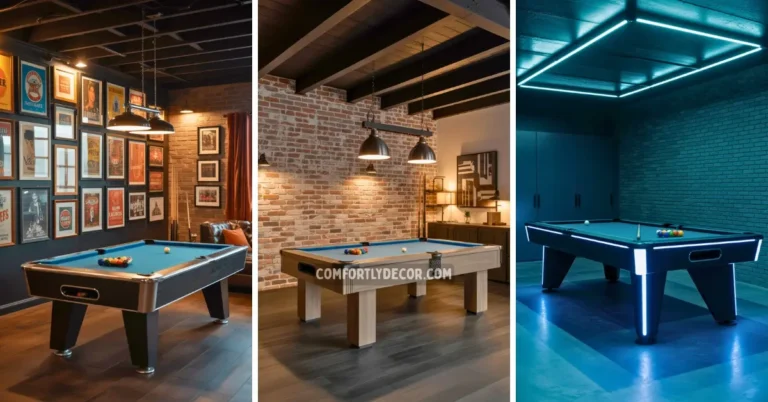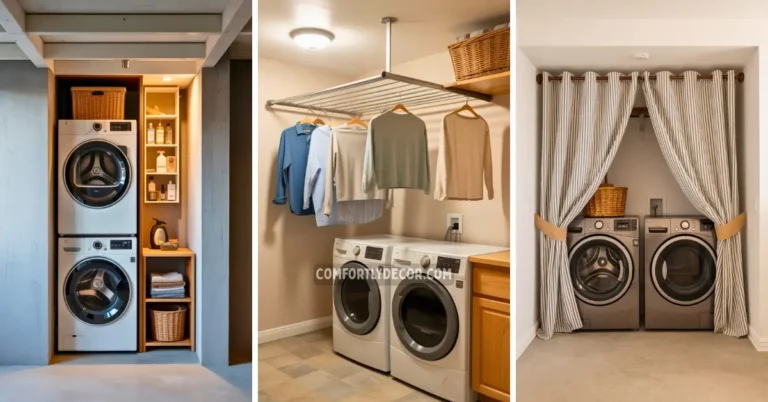20 Clever Low Ceiling Basement Ideas to Maximize Space and Style
Got a basement with ceilings that feel a bit too close for comfort? Yeah, I hear you. Low ceilings can make even the coolest basement feel cramped and cave like. But here is the good news. With a few smart design moves, you can totally transform that space into something stylish and surprisingly spacious.
I have spent way too much time figuring out how to make low ceiling basements work (trust me, it was a journey), and I am here to share what actually makes a difference. Whether you are turning your basement into a home theater, a cozy hangout spot, or just trying to make it less dungeon like, these 20 ideas will help you max out every inch without feeling squished.
20 Low Ceiling Basement Ideas
Ready to make your low ceiling basement look taller, brighter, and way more inviting? Let me walk you through some ideas that genuinely work.
1. Exposed Beams Painted White
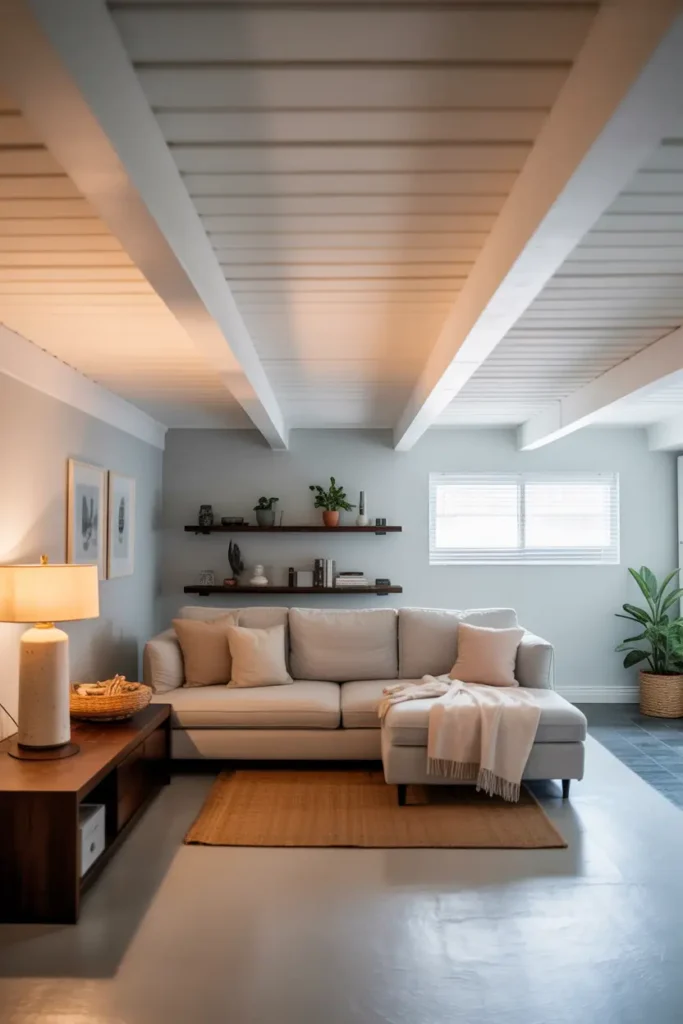
If your basement has exposed beams, do not hide them. Paint them white or a light neutral shade to blend with the ceiling. This trick draws the eye upward and creates an airy, loft like vibe.
Dark beams? They just make the ceiling feel heavier and lower. White beams open things up and add a modern industrial touch.
Plus, it is way cheaper than installing a drop ceiling.
2. Low Profile Recessed Lighting

Forget about chunky light fixtures that hang down and eat up headroom.
Recessed lighting sits flush with the ceiling, so you get all the brightness without losing precious inches. I love using dimmable LED recessed lights because they let you control the mood.
Bright when you need it, soft when you want to chill. Game changer for low ceiling basements, seriously.
3. Vertical Wall Paneling to Elongate Space
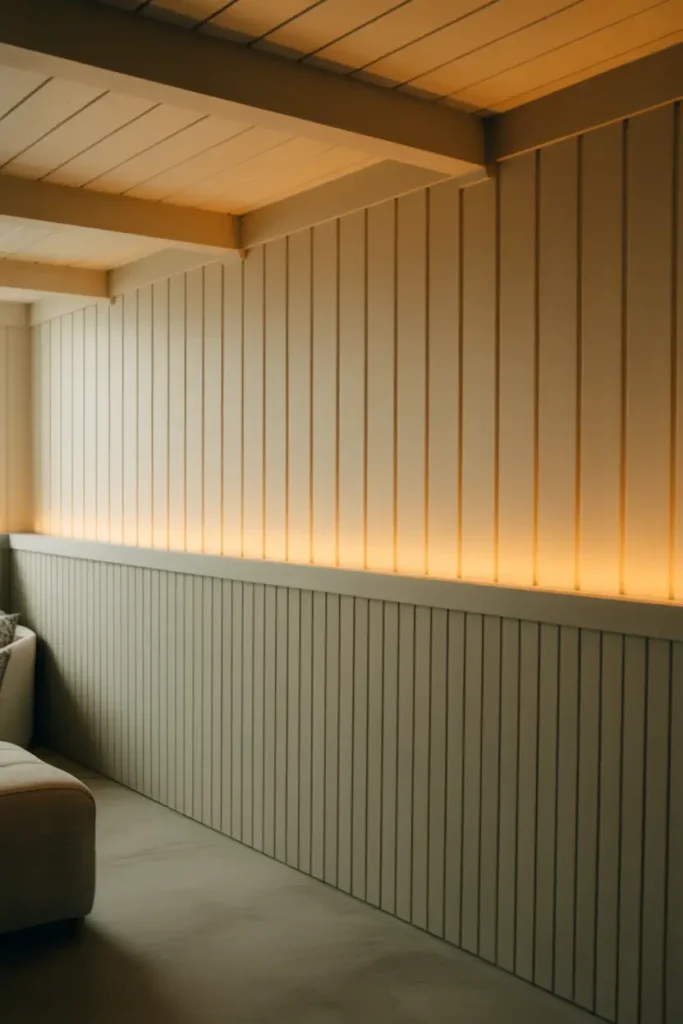
Want to trick the eye into seeing height where there is not much?
Add vertical wall paneling. Shiplap, board and batten, or even simple wood strips running from floor to ceiling create vertical lines that pull the gaze upward. It works like magic.
The taller the lines, the taller your space feels. Keep the color light and you have got yourself a winner.
4. Mirrors to Bounce Light

Mirrors are not just for checking your outfit. In a low ceiling basement, they reflect light and make the room feel twice as big.
Lean a large mirror against one wall or hang a few smaller ones in a gallery style arrangement. The reflected light bounces around the space, brightening things up and adding depth.
Instant spaciousness, no construction required.
5. Light Monochrome Color Palette
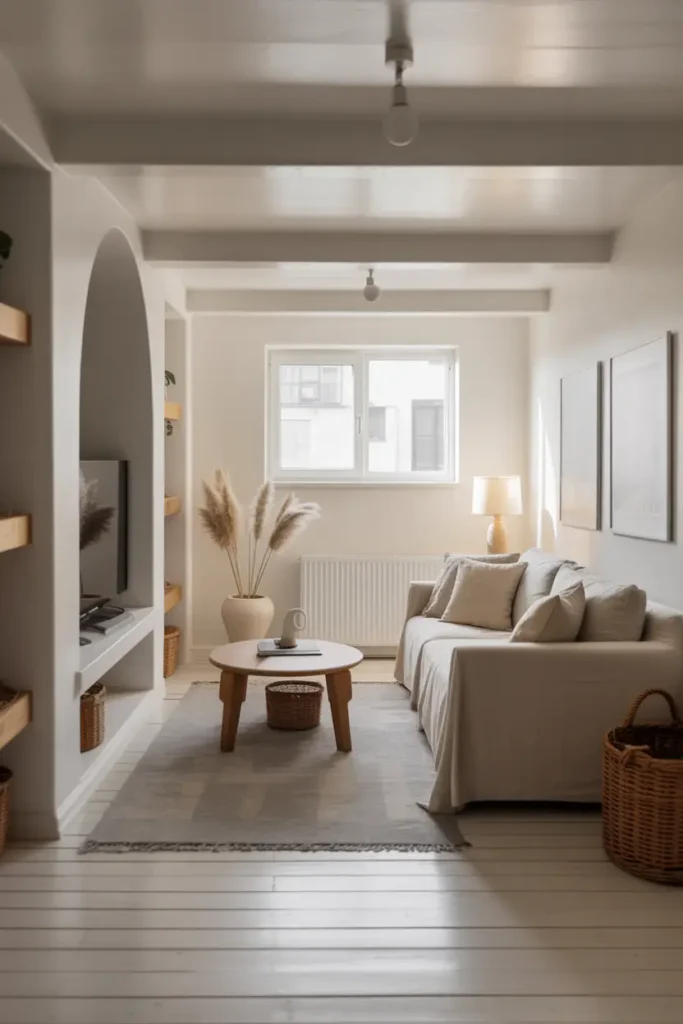
Dark colors absorb light and make everything feel smaller. Light colors? They do the opposite.
Stick with a monochrome palette of whites, creams, light grays, or soft beiges. This creates a seamless look that makes walls and ceilings blur together, giving the illusion of more space.
Throw in some texture to keep it interesting, and you are golden.
6. Minimalist Built In Furniture
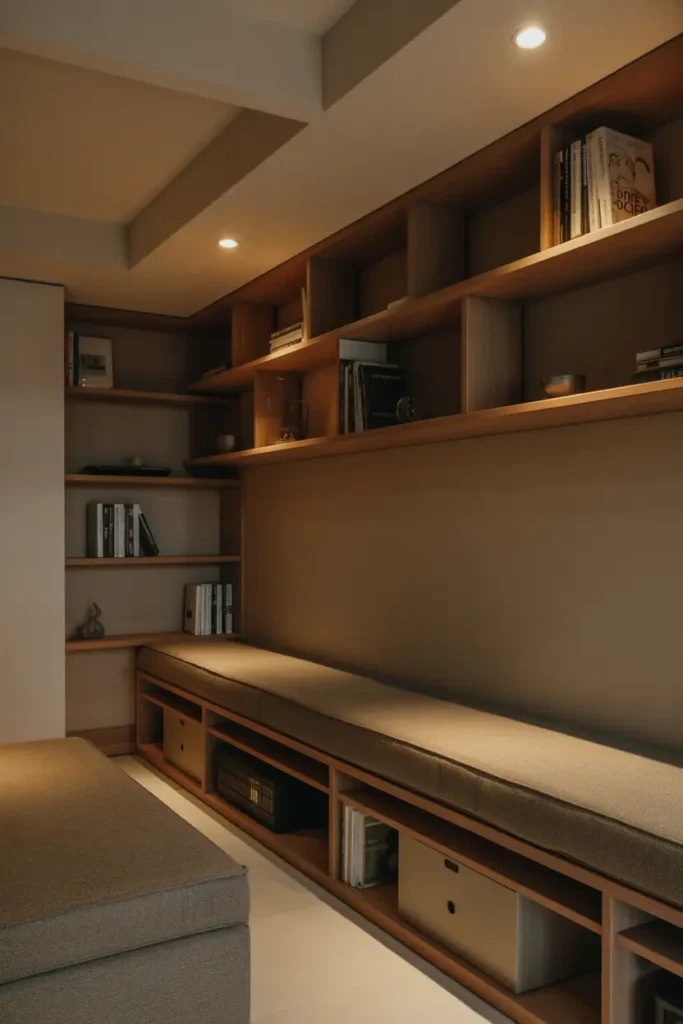
Bulky furniture takes up space visually and physically. Instead, go for sleek built in pieces that hug the walls. Think built in shelves, benches, or storage units that do not jut out into the room.
Minimalist design keeps things clean and uncluttered, which helps a low ceiling basement feel more open and less cramped.
7. Drop Ceiling with LED Perimeter Lights

Okay, so drop ceilings get a bad rap. But if you install LED strip lights around the perimeter, you can create a floating effect that adds visual height.
The soft glow around the edges draws attention outward and upward, making the ceiling feel less oppressive.
Pick panels in white or light tones to keep it feeling airy.
8. Glossy Paint for Light Reflection
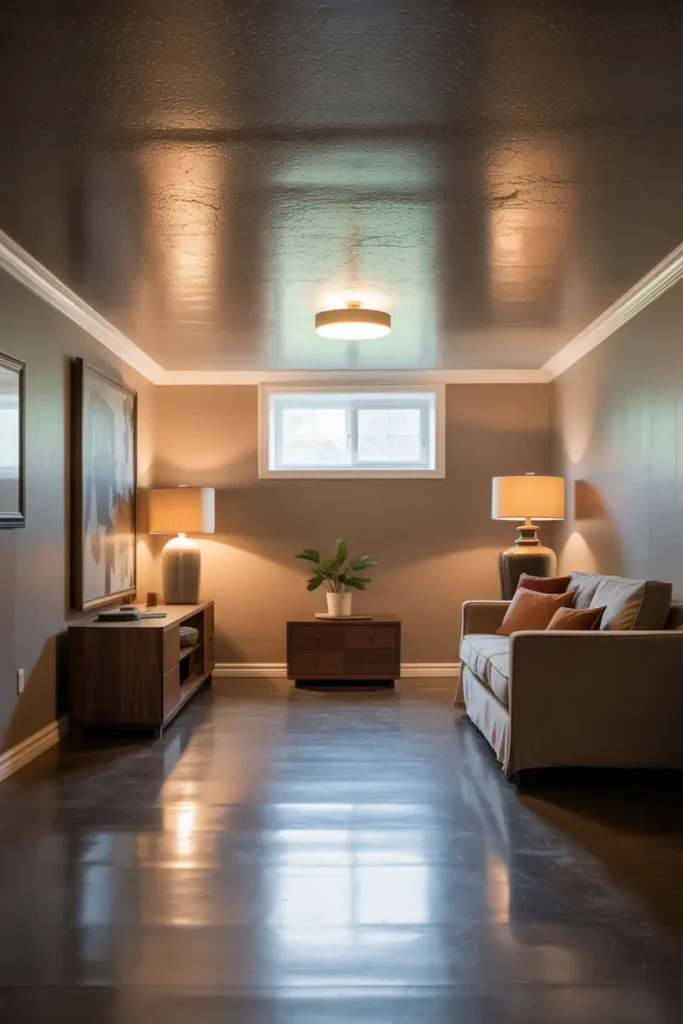
Matte paint is great, but in a low ceiling basement, glossy or semi gloss finishes work better.
They reflect light, making the space feel brighter and more expansive. Use glossy paint on the ceiling and walls to maximize this effect.
It catches light from windows, lamps, and recessed fixtures, bouncing it all around the room.
9. Horizontal Wall Art Layout
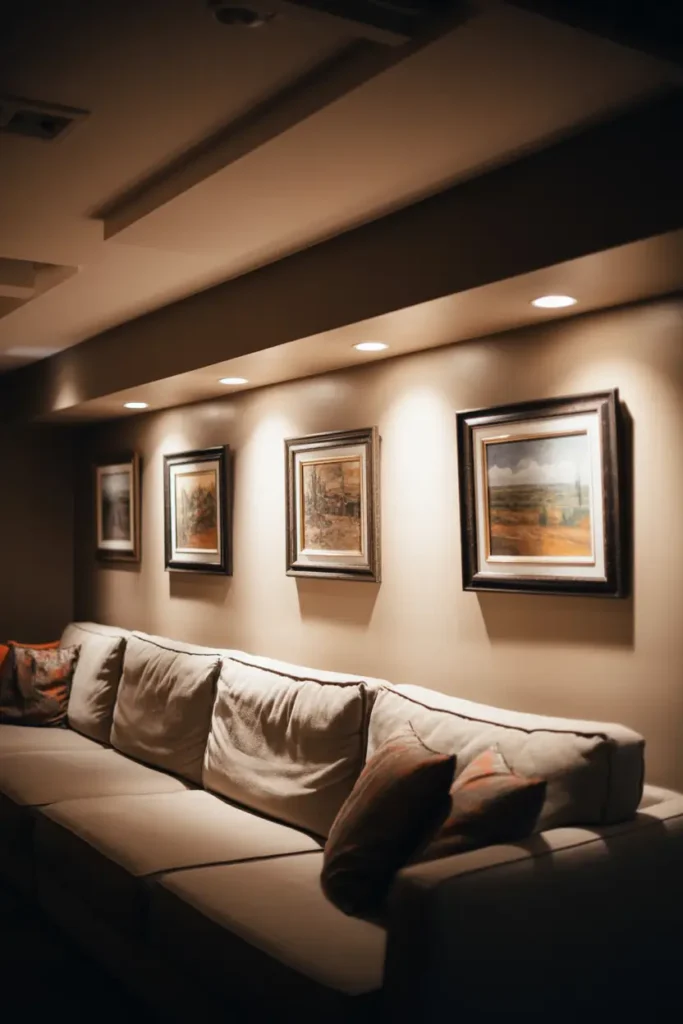
When you hang art horizontally rather than stacking it vertically, you create a sense of width. This draws the eye sideways instead of up and down, which can make the room feel less tall.
Wait, that sounds backwards, right? Actually, by emphasizing width, you distract from the low ceiling and make the overall space feel more balanced and open.
10. Exposed Ductwork in Modern Style

If you have ductwork running across the ceiling, consider leaving it exposed and painting it a sleek color like black, gray, or white.
This industrial look adds character and height because you are not boxing everything in. It feels intentional and modern rather than unfinished.
Just make sure the ducts are clean and neatly arranged for the best effect.
11. Floating Shelves Instead of Tall Units
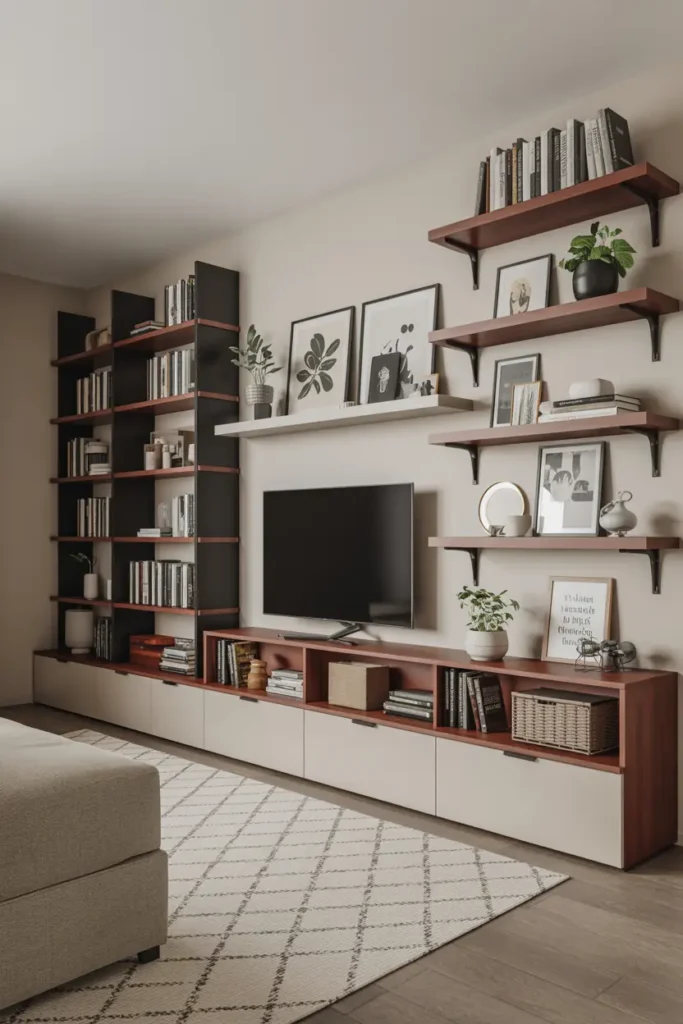
Tall bookcases and storage units can make a low ceiling feel even lower.
Swap them out for floating shelves mounted at different heights. This keeps the floor clear, creates vertical interest, and does not crowd the space.
Plus, floating shelves are super versatile. Use them for books, plants, decor, whatever you need.
12. Compact Seating with Low Backs

High backed sofas and chairs draw attention to how low the ceiling is. Low profile seating, on the other hand, keeps sightlines open and makes the room feel taller.
Look for sofas with low backs, armless chairs, or even floor cushions. You will be amazed at how much more spacious the basement feels with the right furniture.
13. Accent Lighting Behind the Sofa

Adding accent lighting behind furniture creates depth and dimension.
Mount LED strip lights or small sconces behind your sofa or along a wall to cast a soft glow upward.
This indirect lighting makes the ceiling appear higher and adds a cozy, layered vibe to the space. It is an easy upgrade that makes a big impact.
14. Hidden Storage Under Stairs
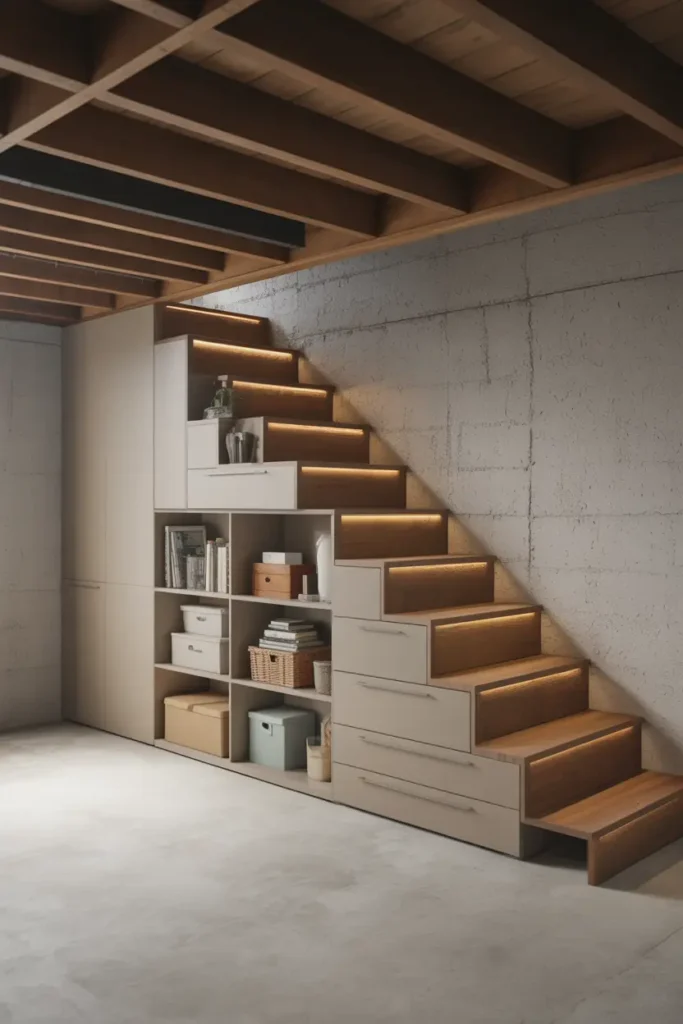
If your basement has stairs, that space underneath is prime real estate. Install pull out drawers, cabinets, or open cubbies to maximize storage without cluttering the room.
Hidden storage keeps the basement tidy, which makes it feel more open. Less mess equals more breathing room, even with a low ceiling.
15. Multi Use Entertainment Corner

Create a dedicated entertainment zone that does double duty. Mount your TV on the wall to save floor space, add low profile media storage, and include comfy seating that can be rearranged.
Keep everything compact and purposeful. A well organized entertainment corner feels intentional and spacious, not cluttered and cramped.
16. Smart Furniture Layout Zoning
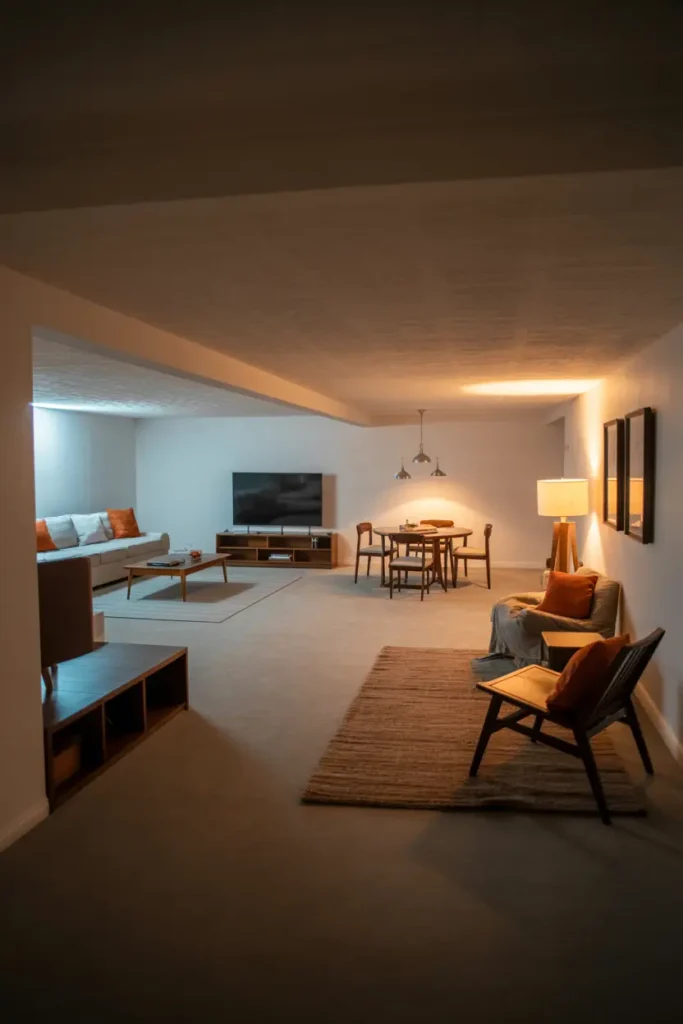
Divide your basement into zones without using walls. Arrange furniture to create distinct areas for watching TV, playing games, or lounging.
This zoning technique makes the space feel larger and more functional. Use rugs, lighting, and furniture placement to define each zone.
It tricks the brain into perceiving more square footage than there actually is.
17. Slimline TV Mount Design
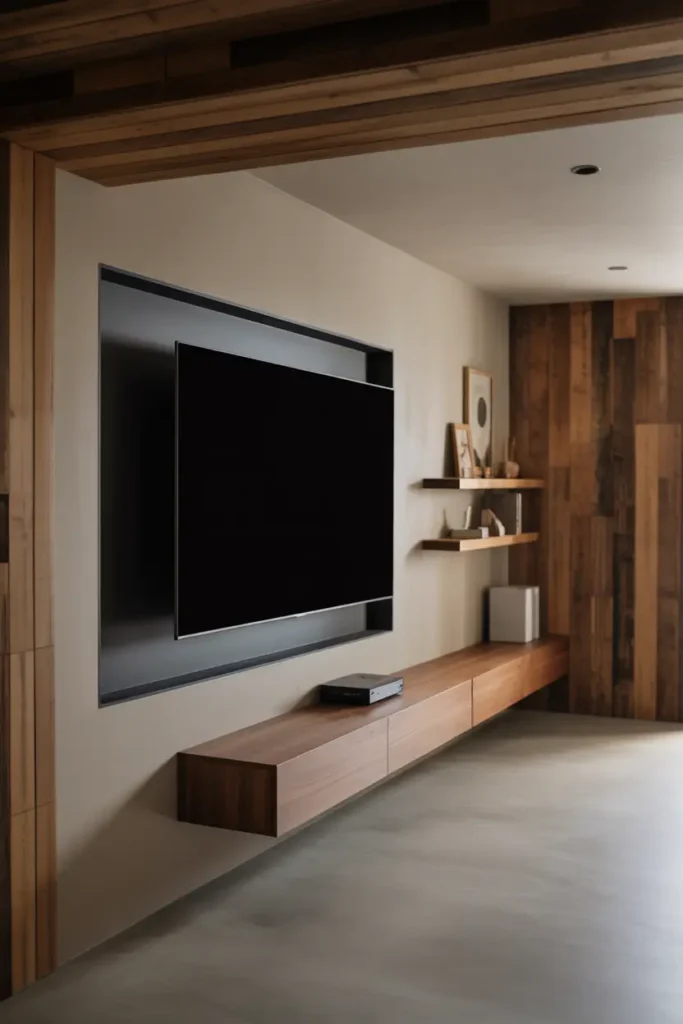
A bulky TV stand eats up floor space and adds visual weight. Instead, mount your TV on the wall with a slim, low profile bracket. This frees up room and keeps sightlines clear.
Pair it with floating shelves or a slim console underneath for storage, and you have got a sleek, modern setup that does not overpower a low ceiling basement.
18. Frameless Glass Partitions

Need to separate areas in your basement without blocking light or making the ceiling feel lower? Frameless glass partitions are the answer.
They define spaces while maintaining an open, airy feel. Light passes through freely, and the lack of heavy frames keeps things looking modern and uncluttered.
Perfect for creating a home office nook or a play area.
19. Polished Concrete Flooring
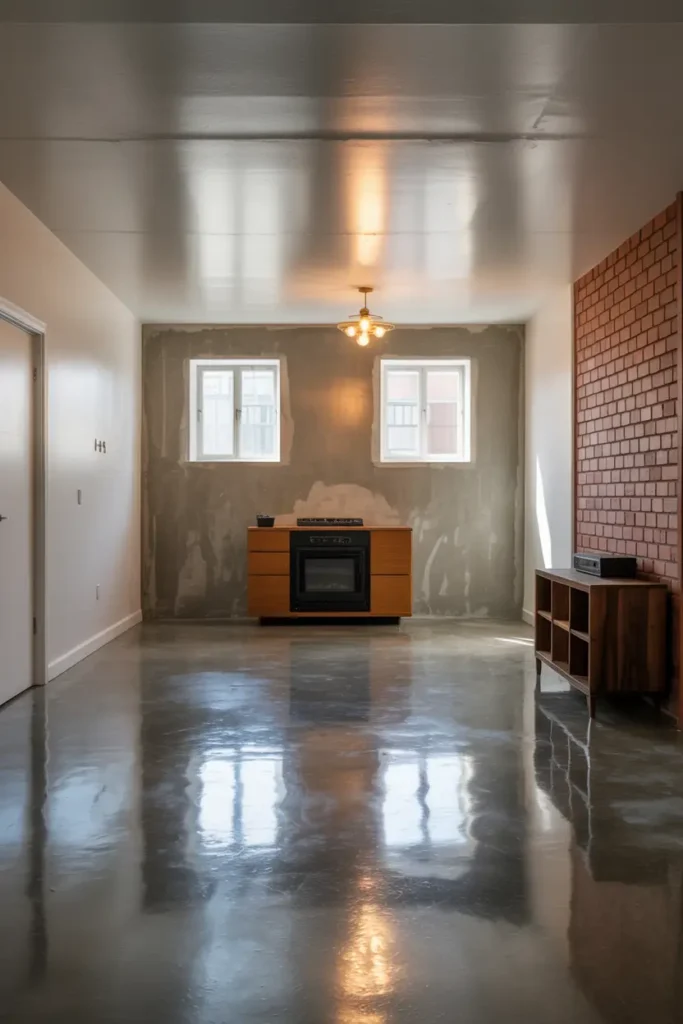
Polished concrete reflects light beautifully and adds an industrial edge that works great in basements. The smooth, glossy surface bounces light around the room, making it feel brighter and more open.
Plus, concrete is durable, low maintenance, and works with almost any design style. It is a smart flooring choice for low ceiling basements.
20. Statement Rug for Visual Height

A bold, large area rug can anchor your basement and add visual interest without taking up vertical space.
Choose a rug with vertical or diagonal patterns to create the illusion of height. The eye follows the lines upward, making the ceiling feel taller.
Plus, a great rug adds warmth and personality to the space.
How to Visually Raise a Low Basement Ceiling
Alright, so you have got a low ceiling and you want it to feel higher. I totally get it. Here are a few extra tricks that work wonders:
Use Vertical Lines Everywhere
Whether it is wall paneling, tall narrow artwork, or curtains that run floor to ceiling, vertical elements draw the eye upward and create the illusion of height.
Keep Clutter to a Minimum
A messy room feels smaller. Keep surfaces clear, use smart storage solutions, and maintain a clean, organized space. Less stuff equals more visual breathing room.
Maximize Natural Light
If your basement has windows, make the most of them. Use sheer curtains or skip them altogether to let in as much light as possible. Natural light makes any space feel bigger and more open.
Choose Furniture Wisely
Go for pieces with exposed legs rather than bulky bases. This creates visual space underneath, making the room feel less crowded and the ceiling less oppressive.
Paint the Ceiling Lighter than the Walls
A lighter ceiling recedes visually, making it feel higher. Even a shade or two lighter than your wall color can make a noticeable difference.
FAQs
Low Ceilings, High Style: Yes, It is Possible
Look, a low ceiling basement does not have to feel like a bunker. With the right design choices, you can turn it into a space that feels open, stylish, and totally livable. Whether you go for exposed beams, recessed lighting, or a killer statement rug, the key is making smart, intentional choices that maximize every inch.
So go ahead, try a few of these ideas and watch your basement transform. You might just end up spending more time down there than you ever thought possible. And hey, if all else fails, at least you will have a really cool space to hang out in. Low ceilings, high style? Totally doable.

I am Mindy Medford, a home décor, paint, and design specialist with over a decade of hands-on experience transforming ordinary spaces into cozy, personality-packed havens. Since 2013, I have been helping homeowners discover the art of beautiful yet practical design. I share my love for color, texture, and layout—making stylish interiors & exteriors feel achievable for everyone. Whether it’s picking the perfect paint shade or reimagining a small space, I’m here to guide and inspire.

